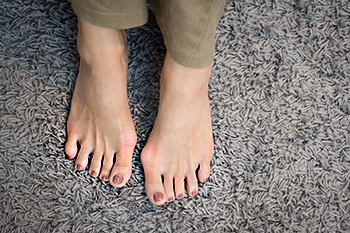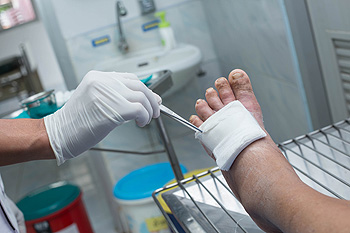Items filtered by date: February 2024
Strategies to Prevent Falls While Working

In every workplace, the risk of falling is a significant concern that demands attention. Mitigating this risk requires a proactive approach and a commitment to safety from both employers and employees alike. First and foremost, maintaining a clean and clutter-free environment is important, as objects left in walkways can easily become tripping hazards. Furthermore, ensuring that floors are dry and free from spills helps prevent slips. Adequate lighting also plays a vital role in enhancing visibility and reducing the likelihood of accidents. Implementing proper training programs for employees is indispensable. This includes educating workers on the importance of using appropriate safety equipment such as non-slip footwear and harnesses when working at heights. Additionally, promoting a culture of mindfulness where employees are encouraged to report potential hazards and participate in safety inspections fosters a safer work environment for everyone. The feet are often hurt when falling occurs, which may compromise the ability to perform daily tasks. If you are interested in having additional knowledge about how falling can impact the feet and methods to prevent this, it is suggested that you consult a podiatrist who can provide you with the information you are seeking.
Preventing falls among the elderly is very important. If you are older and have fallen or fear that you are prone to falling, consult with one of our podiatrists from Sayville Foot Care. Our doctors will assess your condition and provide you with quality advice and care.
Every 11 seconds, an elderly American is being treated in an emergency room for a fall related injury. Falls are the leading cause of head and hip injuries for those 65 and older. Due to decreases in strength, balance, senses, and lack of awareness, elderly persons are very susceptible to falling. Thankfully, there are a number of things older persons can do to prevent falls.
How to Prevent Falls
Some effective methods that older persons can do to prevent falls include:
- Enrolling in strength and balance exercise program to increase balance and strength
- Periodically having your sight and hearing checked
- Discuss any medications you have with a doctor to see if it increases the risk of falling
- Clearing the house of falling hazards and installing devices like grab bars and railings
- Utilizing a walker or cane
- Wearing shoes that provide good support and cushioning
- Talking to family members about falling and increasing awareness
Falling can be a traumatic and embarrassing experience for elderly persons; this can make them less willing to leave the house, and less willing to talk to someone about their fears of falling. Doing such things, however, will increase the likelihood of tripping or losing one’s balance. Knowing the causes of falling and how to prevent them is the best way to mitigate the risk of serious injury.
If you have any questions, please feel free to contact our office located in Sayville, NY . We offer the newest diagnostic and treatment technologies for all your foot care needs.
It's Time for Beautiful Feet
Long-Term Outcomes for Hammertoe Surgery

Hammertoe surgery offers relief from the discomfort and deformity caused by this condition, but understanding its long-term outcomes is important. While surgical intervention can correct toe alignment and alleviate pain, the success of the procedure depends on various factors. Long-term outcomes of hammertoe surgery typically involve improved foot function, reduced pain, and enhanced aesthetics. However, there is a risk of complications such as recurrence of deformity, stiffness, or nerve damage. Proper postoperative care, including wearing appropriate footwear and adhering to rehabilitation protocols, is essential for optimizing results and minimizing complications. Regular follow-up appointments with a podiatrist are also important to monitor the healing process and address any concerns promptly. If you have a painful hammertoe, it is suggested that you schedule an appointment with a podiatrist to see if you are a good candidate for surgery and whether the benefits outweigh the risks in your case.
Foot surgery is sometimes necessary to treat a foot ailment. To learn more, contact one of our podiatrists of Sayville Foot Care. Our doctors will assist you with all of your foot and ankle needs.
When Is Surgery Necessary?
Foot and ankle surgery is generally reserved for cases in which less invasive, conservative procedures have failed to alleviate the problem. Some of the cases in which surgery may be necessary include:
- Removing foot deformities like bunions and bone spurs
- Severe arthritis that has caused bone issues
- Cosmetic reconstruction
What Types of Surgery Are There?
The type of surgery you receive will depend on the nature of the problem you have. Some of the possible surgeries include:
- Bunionectomy for painful bunions
- Surgical fusion for realignment of bones
- Neuropathy decompression surgery to treat nerve damage
Benefits of Surgery
Although surgery is usually a last resort, it can provide more complete pain relief compared to non-surgical methods and may allow you to finally resume full activity.
Surgical techniques have also become increasingly sophisticated. Techniques like endoscopic surgery allow for smaller incisions and faster recovery times.
If you have any questions please feel free to contact our office located in Sayville, NY . We offer the newest diagnostic and treatment technologies for all your foot and ankle needs.
Facts About Bunions

Bunions, a common foot condition, affect millions worldwide. Bunions occur when the joint at the base of the big toe becomes enlarged and protrudes outward. Often caused by genetics, foot stress, or from wearing improper footwear, bunions can lead to pain, swelling, and difficulty walking. Understanding the symptoms is essential in properly treating a bunion. Look for redness, inflammation, and a visible bump at the base of the big toe. While bunions may be managed with proper footwear and orthotics, severe cases may require surgery to realign the toe joint. Prevention is vital, and it is beneficial to opt for shoes with wide-toe boxes and low heels, in addition to avoiding shoes that are tight-fitting or pointed. Simple exercises like toe stretches and foot massages can also alleviate discomfort. Regular foot exams by a podiatrist can catch bunions early and prevent worsening. Bunions are manageable with proper care and attention. If you see a bunion developing, it is suggested that you confer with a podiatrist who can confirm the diagnosis, and offer appropriate relief and treatment methods.
If you are suffering from bunions, contact one of our podiatrists of Sayville Foot Care. Our doctors can provide the care you need to keep you pain-free and on your feet.
What Is a Bunion?
A bunion is formed of swollen tissue or an enlargement of boney growth, usually located at the base joint of the toe that connects to the foot. The swelling occurs due to the bones in the big toe shifting inward, which impacts the other toes of the foot. This causes the area around the base of the big toe to become inflamed and painful.
Why Do Bunions Form?
Genetics – Susceptibility to bunions are often hereditary
Stress on the feet – Poorly fitted and uncomfortable footwear that places stress on feet, such as heels, can worsen existing bunions
How Are Bunions Diagnosed?
Doctors often perform two tests – blood tests and x-rays – when trying to diagnose bunions, especially in the early stages of development. Blood tests help determine if the foot pain is being caused by something else, such as arthritis, while x-rays provide a clear picture of your bone structure to your doctor.
How Are Bunions Treated?
- Refrain from wearing heels or similar shoes that cause discomfort
- Select wider shoes that can provide more comfort and reduce pain
- Anti-inflammatory and pain management drugs
- Orthotics or foot inserts
- Surgery
If you have any questions, please feel free to contact our office located in Sayville, NY . We offer the newest diagnostic and treatment technologies for all your foot care needs.
Diabetic Ulcers and Wound Care

Diabetic foot ulcers are a severe problem for people with diabetes and can lead to serious health issues, such as amputations. To treat diabetic foot ulcers, podiatrists typically use methods like cleaning the wound, using special dressings, taking care of the patient's overall health, and checking blood vessels. There is ongoing research that explores additional treatments to speed up healing and reduce the need for amputations. These extra treatments include things like specific types of dressings, oxygen therapy, and growth factors. More research is needed to confirm their effectiveness. If you suffer from diabetic foot ulcers, it is strongly suggested that you are under the care of a podiatrist who can perform regular foot exams. Treating these types of ulcers as early as possible is essential to an easier healing process.
Wound care is an important part in dealing with diabetes. If you have diabetes and a foot wound or would like more information about wound care for diabetics, consult with one of our podiatrists from Sayville Foot Care. Our doctors will assess your condition and provide you with quality foot and ankle treatment.
What Is Wound Care?
Wound care is the practice of taking proper care of a wound. This can range from the smallest to the largest of wounds. While everyone can benefit from proper wound care, it is much more important for diabetics. Diabetics often suffer from poor blood circulation which causes wounds to heal much slower than they would in a non-diabetic.
What Is the Importance of Wound Care?
While it may not seem apparent with small ulcers on the foot, for diabetics, any size ulcer can become infected. Diabetics often also suffer from neuropathy, or nerve loss. This means they might not even feel when they have an ulcer on their foot. If the wound becomes severely infected, amputation may be necessary. Therefore, it is of the upmost importance to properly care for any and all foot wounds.
How to Care for Wounds
The best way to care for foot wounds is to prevent them. For diabetics, this means daily inspections of the feet for any signs of abnormalities or ulcers. It is also recommended to see a podiatrist several times a year for a foot inspection. If you do have an ulcer, run the wound under water to clear dirt from the wound; then apply antibiotic ointment to the wound and cover with a bandage. Bandages should be changed daily and keeping pressure off the wound is smart. It is advised to see a podiatrist, who can keep an eye on it.
If you have any questions, please feel free to contact our office located in Sayville, NY . We offer the newest diagnostic and treatment technologies for all your foot care needs.

